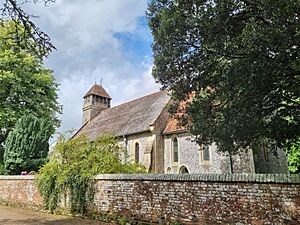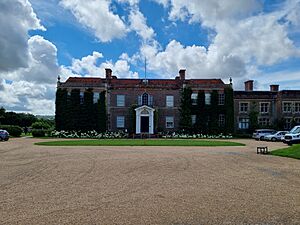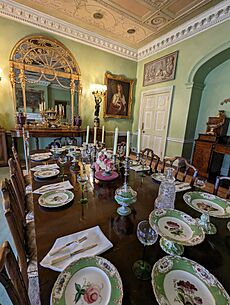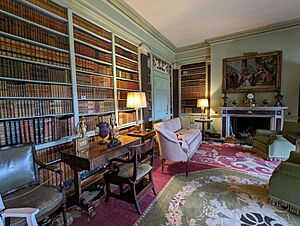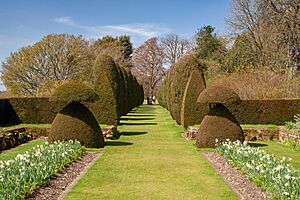Hinton Ampner facts for kids
Quick facts for kids Hinton Ampner |
|
|---|---|
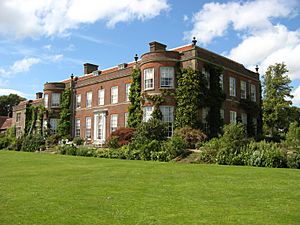
Garden front of house
|
|
| Type | Country house |
| Location | Bramdean and Hinton Ampner |
| OS grid reference | SU 59639 27483 |
| Area | Hampshire |
| Built | 1793 |
| Architect |
|
| Architectural style(s) | Neo-Georgian |
| Owner | National Trust |
|
Listed Building – Grade II
|
|
| Official name: Hinton Ampner House | |
| Designated | 5 December 1955 |
| Reference no. | 1095121 |
| Lua error in Module:Location_map at line 420: attempt to index field 'wikibase' (a nil value). | |
Hinton Ampner is a small village and a large country house estate in Hampshire, England. It is located near Alresford and about eight miles east of Winchester. The village sits on a high chalk ridge, with the house and church at the very top. This area is part of the Hampshire Downs, which is mostly made of chalk hills.
The main house at Hinton Ampner is a special building, listed as Grade II. Both the house and its beautiful gardens are looked after by the National Trust. They are open for people to visit and explore.
Contents
What's in a Name?
The name "Hinton" comes from old English words meaning "homestead on the high ground." This makes sense because the village is on a hill! The second part, "Ampner," is a changed version of "Almoner." An Almoner was a person who gave out money or food to the poor. This part of the name shows that an Almoner from St. Swithuns Priory once owned the land.
A Look Back in Time
People have lived in the area around Hinton for a very long time. There is proof of activity from the Neolithic (New Stone Age) and Bronze Age, including old burial mounds called barrows. The first official record of the village was in the Domesday Book in 1086. This book listed the land and a church.
In 1931, the village had 330 people living there. In 1932, Hinton Ampner joined with the nearby area of Bramdean to form one larger parish.
All Saints Church
The local church, called All Saints Church, is located between the main house and the village cottages. Most of the church was built in the 1200s. However, it also has some parts from an even older church that existed before the Norman Conquest in 1066.
The church was changed a bit in the early 1800s, and its bell tower was updated. Inside, you can find many memorials for the past owners of the estate. There are also three old bells: two from 1603 and one from 1719.
Ralph Dutton, a later owner of the estate, saved some items and memorials from another church that was torn down in the 1950s. He brought them to All Saints. He also asked artists Patrick Reyntiens and John Piper to design two new windows for the church in 1970. All Saints Church is a very important building, listed as Grade II*.
Hinton Ampner House
In the 1540s, a large Tudor style manor house was built at Hinton Ampner. By 1597, the Stewkeley family owned the house. Later, in 1719, the estate went to Mary Stewkeley, who married Edward Stawell. One of their family members, Henry Stawell Bilson-Legge, later inherited the estate. He decided to tear down the old Tudor house. The old house used to stand where the orchard is today.
The house you see today at Hinton Ampner was built in 1793. It was changed a lot in 1867. The house became part of the Dutton family in 1803. This happened when Mary Bilson-Legge, who owned the land, married John Dutton.
Ralph Dutton, the last private owner, inherited the estate in 1935. He really disliked the Victorian style of the house at the time. So, between 1936 and 1939, he had the house completely changed. He wanted it to look like a grand Georgian country house from the 1790s. Architects Trenwith Wills and Lord Gerald Wellesley helped him achieve this vision.
During World War II, the house was used as a safe place for girls from Portsmouth Girls School. This kept them away from the city during the war. In April 1960, a big fire badly damaged the house. Almost every room was affected by fire or smoke. But restoration work started quickly, and the house was rebuilt by May 1963. The roof line was even changed back to its original Georgian shape. Ralph Dutton filled the house with many beautiful pieces he collected from other grand homes. He worked with designer Ronald Fleming to make the rooms look perfect for his collection.
Ralph Dutton had no children to leave the estate to. So, when he passed away in 1985, he gave Hinton Ampner to the National Trust. He is buried in the graveyard of the nearby All Saints Church.
Inside the House
Ralph Dutton loved collecting furniture and art from the early 1700s. The house is now filled with amazing examples of art and decorative items from the Regency period. Ralph Dutton even used money he earned from writing books about architecture and history to buy some of these treasures.
The Entrance Hall
A special feature in the entrance hall is the fireplace made of a dark, strong rock called porphyry. Ralph Dutton saved this fireplace from another grand house called Hamilton Palace. Above it hangs a painting called Selene and Endymion by Giovanni Antonio Pellegrini. The tall, golden candle holders (called torchères) were bought from a sale in 1949.
The Dining Room
The dining room has a ceiling that looks like one designed by Robert Adam, a famous architect. This ceiling was originally meant for another house but was going to be torn down. So, parts of it were carefully moved and recreated in the dining room. This included taking off painted pictures by Angelica Kauffman and making copies of Adam's plasterwork. The work was finished in 1940, but sadly, much of it was destroyed in the 1960 fire, including all of Kauffman's paintings. Ralph Dutton hired Elizabeth Biddulph to repaint all the pictures. The mirror in the room was also designed by Robert Adam. There are also two interesting paintings of small, winged figures (called putti) that look like they are popping out of the wall.
The Library
All of Ralph Dutton's books were destroyed in the 1960 fire. He replaced them all with new books he bought. The fireplace in the library is made of marble and porphyry. It has symbols that might have belonged to Napoleon. Above the fireplace hangs a painting called Esther Fainting Before Ahasuerus by Francesco Fontebasso.
Ghost Stories
The old Tudor house at Hinton Ampner became famous in the 1700s because people said it was haunted by a poltergeist. A poltergeist is a ghost that makes loud noises or moves objects. One person who lived there, Mary Ricketts, wrote about her experiences. She heard strange sounds and saw ghostly figures. The old house was torn down in 1793, and the new house was built about 50 feet away.
A writer named Harry Price wrote a lot about these ghost claims in his book Poltergeist Over England (1945). However, another person named Trevor H. Hall disagreed. He thought that underground water might have caused the noises. He also suggested that some of the sounds could have been from small earthquakes.
The Gardens
The beautiful gardens you see today were created by Ralph Dutton, starting in 1930. Before that, the open parkland came right up to the house. Ralph Dutton completely redesigned the gardens. He added a lily pond along the east side of the house and replanted the terraces on the south side. The formal gardens are especially known for their wide variety of roses. The entire estate, including the house and gardens, covers 667 hectares of chalk farmland and woodland. Ralph Dutton also replanted the woodland. All of this was given to the National Trust in 1985.


